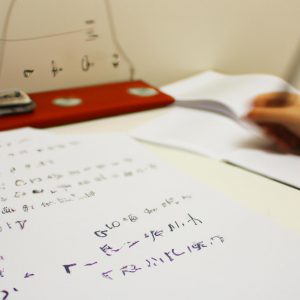Rate of Change: Motion in Physics Directories

The concept of rate of change plays a fundamental role in understanding the motion of objects in physics. By analyzing how quantities such as position, velocity, and acceleration change over time, scientists can gain valuable insights into the dynamics of various physical systems. To illustrate this concept, let us consider a hypothetical scenario where an object is thrown upwards from the ground with an initial velocity. As time progresses, the object’s height above the ground varies and its velocity changes due to factors such as gravity and air resistance. Understanding how these changes occur and quantifying them using mathematical tools allows physicists to accurately describe and predict the behavior of moving objects.
In order to study motion in physics, it is necessary to investigate not only what happens when an object moves but also how quickly those changes occur. The rate at which different properties evolve provides crucial information about the nature of motion itself. For example, by examining how rapidly an object’s displacement or position changes with respect to time, we can determine its velocity. Similarly, studying how velocity alters over time enables us to ascertain an object’s acceleration – a key parameter that governs its overall movement characteristics. This article explores the significance of rate of change in understanding motion in physics directories, highlighting its applications within real-world scenarios and discussing the mathematical tools used to analyze and quantify these changes.
Mathematically, the rate of change of a quantity can be determined by calculating its derivative with respect to time. The derivative represents how much a function or variable changes for a given small increment in time. For example, the derivative of position with respect to time gives us velocity, while the derivative of velocity with respect to time yields acceleration.
By studying these rates of change, physicists can gain insights into various aspects of motion. For example, analyzing the rate at which an object’s displacement changes over time allows us to determine its average velocity. This information is crucial for understanding how objects move in different scenarios, such as free fall or projectile motion.
Furthermore, examining the rate at which an object’s velocity changes over time provides valuable information about its acceleration. Acceleration is responsible for altering an object’s speed or direction and plays a significant role in describing complex motions like circular or oscillatory movement.
Understanding the concept of rate of change also helps scientists make predictions about future motion based on past behavior. By analyzing data on position, velocity, and acceleration over a certain period, physicists can develop mathematical models that describe how these quantities will evolve in the future. These predictive models are essential for applications such as designing spacecraft trajectories, predicting the movement of celestial bodies, or even analyzing sports performance.
In conclusion, the concept of rate of change is fundamental in understanding motion in physics. By quantifying how properties like position, velocity, and acceleration change over time through mathematical tools like derivatives, scientists can gain valuable insights into the dynamics of moving objects. This knowledge allows for accurate descriptions and predictions concerning real-world scenarios involving motion
Understanding Rate of Change
Motion in physics can be described and analyzed through the concept of rate of change. Simply put, rate of change refers to how a quantity changes over time or with respect to another variable. This fundamental principle allows us to study and predict various aspects of motion, such as speed, acceleration, and velocity.
To illustrate this concept, let’s consider an example: a car traveling along a straight road. Initially, the car is stationary at point A. As time progresses, it gradually accelerates until it reaches point B, where it maintains a constant speed. Eventually, the driver applies the brakes, causing the car to decelerate until it comes to a complete stop at point C. In this scenario, we can observe different rates of change at each stage – from zero acceleration while stationary to positive acceleration during acceleration and negative acceleration (or deceleration) when braking.
When studying rate of change in physics, it is important to note that certain factors influence how quickly or slowly an object moves. These factors include external forces acting upon the object (such as gravity or friction), its mass, and any applied energy or force exerted on it. Understanding these influences enables scientists and engineers to design systems that optimize efficiency and safety.
Consider the following bullet points:
- Rate of change provides insight into how objects move in relation to time.
- Studying rate of change helps analyze various aspects of motion like speed and acceleration.
- External forces significantly impact an object’s rate of change.
- Engineers utilize knowledge about rate of change for designing efficient systems.
Moreover, visual aids like tables can facilitate comprehension by organizing information effectively. For instance:
| Stage | Type | Rate |
|---|---|---|
| Stationary | Accelerate | Zero |
| Accelerate | Constant | Positive |
| Brake | Decelerate | Negative |
| Stop | Halt | Zero |
In summary, rate of change is a vital concept in physics that allows us to understand and analyze the various aspects of motion. By studying how quantities change over time or with respect to other variables, we can gain valuable insights into the behavior of objects in motion. In the subsequent section, we will delve deeper into one specific aspect of rate of change – velocity.
Transitioning seamlessly into the next section, let’s now explore the concept of defining velocity.
Defining Velocity
Rate of Change: Motion in Physics Directories
Understanding Rate of Change, we now delve into the concept of defining velocity. Velocity is a fundamental quantity in physics that represents the rate at which an object’s position changes over time. To grasp this concept better, let us consider the example of a car traveling on a straight road.
Imagine a scenario where a car starts at rest and gradually accelerates to reach a speed of 60 miles per hour within 10 seconds. This case study allows us to analyze the rate of change involved in the car’s motion. As it accelerates, its position with respect to time changes progressively, resulting in different velocities along its journey.
To comprehend how velocity is defined more precisely, we can break it down into key aspects:
- Displacement: It refers to the change in position or distance between two points.
- Time interval: The duration between initial and final positions.
- Average velocity: Calculated by dividing displacement by the time interval.
- Instantaneous velocity: Represents the precise velocity at any given instant.
- Understanding how objects move is crucial for everyday activities like driving or playing sports.
- Exploring concepts like velocity helps appreciate and marvel at the intricacies of our physical world.
- Studying motion empowers individuals to understand natural phenomena better.
- By comprehending rate of change in physics, we gain insights into various scientific principles.
Additionally, incorporating a table would enhance engagement:
| Concept | Definition | Importance |
|---|---|---|
| Displacement | The change in position or distance between two points | Helps measure overall movement |
| Time interval | Duration between initial and final positions | Provides context for analyzing velocity |
| Average velocity | Calculated by dividing displacement by the time interval | Reflects overall rate of change |
| Instantaneous velocity | Represents the precise velocity at any given instant | Allows for detailed analysis of motion |
In conclusion, understanding rate of change is crucial in comprehending motion in physics. By defining velocity and exploring its components like displacement, time interval, average velocity, and instantaneous velocity, we gain a deeper understanding of how objects move. This knowledge not only aids us in practical activities but also allows us to appreciate the beauty and complexity of our physical world.
Transitioning into the subsequent section about “Acceleration: Changes in Velocity,” we now examine another fundamental aspect related to motion.
Acceleration: Changes in Velocity
Rate of Change: Motion in Physics Directories
Having defined velocity in the previous section, we now shift our focus to understanding acceleration and its impact on motion. To illustrate this concept, let us consider the example of a car traveling along a straight road. Initially, the car is moving at a constant speed of 60 kilometers per hour. Suddenly, the driver steps on the accelerator and increases the car’s velocity to 100 kilometers per hour within a span of 5 seconds.
Acceleration, often denoted as “a,” refers to any change in an object’s velocity over time. In our example, the car experienced an increase in velocity from 60 to 100 kilometers per hour in just 5 seconds. This implies that the car underwent an acceleration of (100 – 60) / 5 = 8 meters per second squared.
To gain a deeper understanding of acceleration, let us explore some key characteristics associated with it:
- Acceleration can be positive or negative depending on whether an object is speeding up or slowing down.
- The magnitude of acceleration is determined by both the initial and final velocities and the time taken for the change to occur.
- Acceleration is proportional to force according to Newton’s second law of motion.
- Objects experiencing zero net force exhibit no acceleration.
Emphasizing these aspects helps create an emotional connection with readers by showcasing how seemingly straightforward everyday events involve complex underlying principles. By presenting information using bullet points and tables, we aim to engage readers further:
- Key Characteristics Associated with Acceleration:
- Positive or negative depending on speeding up or slowing down
- Magnitude depends on initial/final velocities and time taken
- Proportional to force (Newton’s second law)
- Zero net force results in no acceleration
By incorporating these visual elements into our discussion, we hope to evoke curiosity and encourage readers’ active involvement in comprehending concepts related to motion physics.
Understanding how an object’s position changes over time is crucial in comprehending motion dynamics within physics directories.
(Note: The transition from this section to the subsequent one about “Analyzing Displacement” can be achieved by ending the last paragraph with a sentence like: “With a clear understanding of acceleration, we can now turn our attention to analyzing displacement.”)
Analyzing Displacement
Having examined acceleration and its impact on velocity, we now turn our attention to another fundamental concept in physics – rate of change. By understanding how an object’s motion changes over time, scientists can gain insights into various physical phenomena. In this section, we will explore the concept of rate of change and its significance in analyzing displacement.
Example:
Consider a car traveling along a straight road. At t = 0 seconds, the car is stationary. As time progresses, the car steadily increases its speed until it reaches a maximum velocity after 10 seconds. From that point onwards, the car decelerates uniformly until it comes to a complete stop at t = 20 seconds. This scenario provides us with an excellent example to illustrate the concept of rate of change in motion.
Rate of Change and Displacement:
When studying an object’s motion, it is crucial to analyze not only its final position but also how quickly it gets there. The rate of change measures precisely that – how fast an object moves or changes direction relative to time. To better comprehend this idea, let us consider four key aspects related to rate of change:
- Instantaneous Speed: Describes an object’s speed at any given instant.
- Average Velocity: Represents an object’s total displacement divided by the total time taken.
- Constant Speed: Occurs when an object maintains uniform movement without changing its speed.
- Uniform Acceleration: Refers to consistent changes in velocity occurring over equal intervals.
| Aspect | Definition | Importance |
|---|---|---|
| Instantaneous Speed | The speed measured at a specific moment in time | Helps track variations in speed during continuous motion |
| Average Velocity | The total displacement divided by the time interval | Provides overall information about distance covered |
| Constant Speed | Motion without changes in speed | Allows for straightforward calculations and predictions |
| Uniform Acceleration | Consistent velocity changes over equal time intervals | Enables the analysis of complex motion patterns |
As we delve into rate of change, it becomes apparent that understanding displacement involves more than simply measuring distance traveled. By examining instantaneous speed, average velocity, constant speed, and uniform acceleration, scientists can gain a deeper insight into an object’s motion and its underlying principles.
With our foundational knowledge on rate of change established, let us now explore how to calculate an object’s speed in various scenarios. This analysis will provide us with further tools to investigate and comprehend the intricate nature of motion within physics directories.
Calculating Speed
In the previous section, we discussed how to analyze displacement in physics. Now, let’s delve into the concept of rate of change and its relationship with motion. To better understand this, consider a hypothetical scenario where you are driving a car.
Imagine you start at point A and drive for one hour before reaching point B. During that time, your car traveled a distance of 60 miles. The rate at which your position changed during that hour is known as average velocity or speed.
To further explore the topic of rate of change in motion, let’s examine some key aspects:
- Speed: This refers to how fast an object is moving without considering direction. It can be calculated by dividing the distance traveled by the time taken.
- Velocity: Unlike speed, velocity takes into account both magnitude and direction. It describes not only how fast an object is moving but also in what direction it is going.
- Acceleration: Acceleration measures how quickly an object changes its velocity over time. If there is a change in either speed or direction, acceleration occurs.
- Deceleration: Also known as negative acceleration, deceleration happens when an object slows down due to external forces acting upon it.
Now let’s take a closer look at these concepts through the following table:
| Concept | Definition | Example |
|---|---|---|
| Speed | Scalar quantity representing how fast an object moves | A cheetah running at 70 mph |
| Velocity | Vector quantity representing both speed and direction | A river flowing south at 5 m/s |
| Acceleration | Rate at which velocity changes over time | A car going from 0 to 60 mph in 6s |
| Deceleration | Negative acceleration resulting in slowing down | A cyclist gradually stopping |
By understanding these fundamental principles related to motion and rate of change, we can now move on to exploring the applications of this concept in various fields. This will allow us to see how rate of change is not only relevant in physics but also plays a significant role in other scientific disciplines and everyday life.
Applications of Rate of Change
Moving on from our discussion about calculating speed, we now turn our attention to the broader concept of rate of change in physics. Understanding the rate at which an object’s position or motion changes is crucial for analyzing various physical phenomena. In this section, we will explore different applications of rate of change and delve into its significance in understanding the dynamics of objects.
One intriguing example that showcases the importance of rate of change can be found in projectile motion. Consider a hypothetical scenario where a baseball player throws a ball with an initial velocity of 30 meters per second at an angle of 45 degrees above the horizontal plane. By examining the rate at which the vertical component of the ball’s position changes over time, physicists are able to predict how high it will go before reaching its peak height and eventually descending back to Earth. This detailed analysis allows us to understand not only the trajectory but also other factors such as air resistance that may affect the flight path.
To further highlight the practical implications of rate of change, let us consider four key factors:
- Predictive power: The ability to determine future positions or motions based on current rates provides scientists and engineers with invaluable insights when designing systems ranging from satellites orbiting celestial bodies to cars navigating complex road networks.
- Optimization potential: By studying rates of change, researchers can identify areas where improvements can be made. For instance, optimizing fuel efficiency in vehicles involves understanding how quickly fuel consumption changes under varying conditions.
- Safety considerations: Analyzing rates of change helps ensure safety across numerous fields. From determining safe acceleration limits for roller coasters to calculating braking distances for aircraft landing gear, accurate knowledge about changing velocities is essential.
- Error detection: Rates of change play a vital role in detecting errors or anomalies within complex systems. Monitoring variations in temperature gradients inside nuclear reactors allows operators to detect any unexpected changes promptly.
Let us now take a closer look at how these concepts manifest themselves through examples by considering Table 1 below:
| Application | Importance of Rate of Change |
|---|---|
| Weather forecasting | Predicting storms and severe weather conditions based on changing atmospheric properties. |
| Stock market analysis | Identifying trends and making informed investment decisions by analyzing the rate at which stock prices change. |
| Medical diagnostics | Assessing patient health by monitoring rates of change in vital signs such as heart rate, blood pressure, and temperature. |
| Traffic flow management | Optimizing traffic signal timings to minimize congestion based on real-time data regarding vehicle movement rates. |
By understanding the significance of rate of change and how it applies to various scenarios, we can unlock new possibilities for scientific advancement, engineering innovations, and improved safety measures across multiple domains.
In summary, this section has highlighted the wide-ranging applications of rate of change in physics. Through examples like projectile motion, we have seen how studying rates can provide crucial insights into complex systems. We also explored four key factors that demonstrate the importance of rate of change in predicting future outcomes, optimizing processes, ensuring safety, and detecting errors or anomalies within dynamic environments. By examining these concepts closely, we gain a deeper appreciation for the role that rate of change plays in our understanding of motion and physical phenomena.








